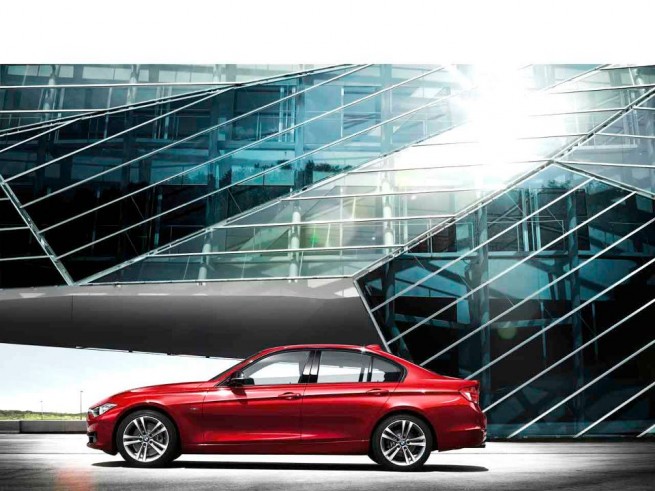BMW believes we’re getting bigger – or at least it seems that way because their cars keep getting bigger. The new F30 3er sedan is dimensionally longer, has a wider track (front & rear) and a longer wheelbase. The one thing is has managed to keep in check is additional weight. The F30 3er is about 80 plus pounds lighter than the old car.
BMW is using high strength steel and heat pressed components to help increase torsional rigidity. The use of high strength specialty steels helps shave weight, since it is more rigid per pound than other steels. For a car to gain a couple of inches in wheelbase and length, as well as having a wider track and still weigh less is very good.
Engine choices at the introduction are both ‘TwinPower’ turbo-charged gas engines. The 328i will be powered by the 2.0L in-line four known as the N20, and the 335i will be powered by the familiar N55 3.0L in-line six. The N20 produces 240 HP and 260 lb-ft of torque in this application and is capable of accelerating the 328i from 0 to 60 mph in 5.7 seconds.
The N55 in the 335i manages to accelerate to 60 in 5.4 seconds from a standstill. Hmmmm . . . three tenths of a second difference between the two?
Either variant of the new 3er is equipped by default with a six speed manual transmission or, optionally, the eight speed automatic can be ordered. The interesting tidbit of note is that the eight speed auto returns better fuel mileage than the six speed manual. Given the advances in transmission technology and the reductions in weight of the slush-box torque converter this isn’t surprising once you consider that two additional overdrive gears exist in the automatic.
The chassis is BMW’s modified MacPherson strut suspension in front (called a Double-pivot front axle) and a five link rear suspension. This basic setup should be familiar to E90 drivers, but it has been refined further in the new F30. Steering is by electrically assisted rack and pinion, in keeping with the EfficientDynamics theme. Brakes are floating caliper all around for the 328i and four-pot fixed calipers front and floating calipers rear for the 335i.
One intriguing aspect of the new 3er is its use of the Comfort, Sport, Sport +, and ECOPRO driving mode settings that we see in its sibling, the 1er. Using information from a suite of sensors the driving experience can be tailored to suit whatever shoes you’re wearing from Birkenstocks to Pilotis. An M sport package will have additional suspension capabilities available for more spirited driving enthusiasts.
The M Sport package will include a lowered suspension (not quite slammed, just a silly 10mm lower), firmer suspension and dampers (shock absorbers to our US readers).
And on the subject of EfficientDynamics, Auto Start-Stop will be included on the new 3er sedan regardless of which transmission is chosen. In addition the on-demand coolant pump, electronically controlled oil pump, and the electromechanical steering system contribute to reduced fuel consumption. The air conditioning compressor is also sitting behind a magnetic clutch to reduce power loss (though that technology isn’t new or exciting – but every little bit helps).
Also careful aerodynamic tuning sees the use of air-curtain aero for the front wheels and significant underbody aero work to help reduce lift, drag, and also NVH.
An ActiveHybrid model of the 3er sedan will be available in autumn of 2012. Using the hybrid nose on the eight speed automatic and the N55 engine from the 335i, the ActiveHybrid 3er will be quick and efficient. It can run up to 37 mph on the electric motor alone and use the electric
motor to assist in acceleration. The electric motor will be engaged as a generator on overrun and braking to return energy to the battery pack.
The battery pack is small and occupies underfloor space in the trunk. Range on electric power only is about 2 to 2.5 miles, enough to get you from the house and onto feeder roads that have speed limits higher than 35 mph.
Of note also is a suite of ConnectedDrive features that will be available such as rear view and surround view cameras, has full color head-up display, Active Blind Spot Detection system, and a Lane Departure Warning system among others. Of course there is a panoply of infotainment options as well as well as a nice high res navigation system coupled to the iDrive functionality. BMW has to be commended for keeping the display screen for the nav system high in the cockpit rather than low on the center stack as some manufacturers do. The less your head has to dip into the cockpit to gather information, the safer you are.
What we are seeing with the new F30 3er is a continuation of the size creep for all BMW models and the proliferation of technical features migrating from the 7er to its smaller siblings. We’ll reserve judgment on driving dynamics until we get our hands on one.





































































